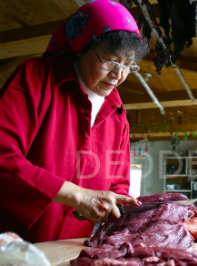Climate Resiliency in Northern Canada
Disproportionate climate change effects felt in remote Northern Canadian communities are being met with resiliency strategies like climate change adaption and community strengthening. Dr. Rebecca Turpin, director of Yukon’s Climate Change Secretariat, explains how resiliency frameworks in the North have been developed.
Some of the extreme climate change impacts that are projected to occur by 2050 elsewhere in the world have already been observed in the Arctic. As a result, people in Canada’s northern communities are facing unprecedented challenges to their ways of life. While Arctic people are working hard to adapt to climate change impacts, these impacts are projected to increase.

Two factors: the remoteness of northern communities; and the disproportionate extent of changes in the north, increase the risks stemming from climate change. Nevertheless, Arctic communities’ resilience stems from strong relationships, self-sufficiency, cooperation, and ongoing connections to the land.
Resilience is about bouncing back or reorganizing to persevere through change. Resilience is specific to people and places. Last year, as part of a Yukon-wide assessment on climate risks, we asked for help to define what climate resilience means for our territory. Consulting with people from different levels of territorial, Indigenous, and municipal governments, who are working in food security, health, housing, and business development, we asked:
“What climate change impacts are you seeing?”
“How are your lives affected?”
“What tools do you have to safeguard the things that matter to you in a changing climate?”
From these discussions, we developed a resilience framework that helped inform how we adapt to climate change. We see climate resilience as the relationship between the impacts from climate change, the things that matter to Yukoners’ ways of life, and how people are taking action to safeguard their community values.
For example, there are climate hazards, including wildland fires, permafrost thaw, changes to snow, water, and ice, changes to vegetation and wildlife, and extreme weather events. These climate hazards impact things that hold value our communities – our infrastructure, food security, energy, culture and heritage, access to important places on the land, community, livelihoods, environmental health, and community health and well-being. Actions to safeguard those values are what help build resilience.
Climate resilience in Yukon is strengthened through…
Climate change adaptation: preparation for emergencies such as flooding and fires, infrastructure maintenance from permafrost thaw, and the monitoring of existing climate change impacts.
Strong communities: building strong relationships, being self-sufficient, cooperation within communities, maintaining ongoing connection to the land, and making the most of our limited resources.
There are many examples of actions that our communities are taking to strengthen our climate resilience. For example, people sharing harvested meat with their neighbours during power outages. A young man from Vuntut Gwitchin First Nation told us:

“You can give someone $300 and they can go to the grocery store and probably have enough food for a week, or you could take that same $300 for gas and ammunition and what you need on the land, and harvest meat that can last you all winter.”
This matters in the North. Old Crow, where that young man is from, is a fly-in community. Most of the other communities in the territory are accessible by only one road, and so there are big risks stemming from power outages, highway washouts, and supply chain shortages.
So many things are connected – we have land guardians across the Yukon, with the guidance of Elders, monitoring how animals and plants are changing. This helps to inform subsistence harvest. In other cases, communities throughout the Yukon are growing their own food to reduce the dependency on southern imports.
Thinking about climate change in this way – a holistic perspective that considers the way that climate change is woven throughout everyday life, helps us emphasize the strengths that exist in our communities. It also helps us identify solutions that are appropriate for life in the North.

















